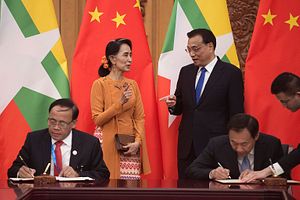More than four years have passed since China formally introduced the “Belt and Road Initiative” (BRI), President Xi Jinping’s signature foreign policy project, in September 2013. In the past few years, China has dedicated significant political and economic resources to ensure the friendly reception of the BRI by the world. Situated in the junction between South Asia and Southeast Asia, and between the Indian Ocean and China’s landlocked southwestern Yunnan province, Myanmar occupies a rather unique position in the Belt and Road Initiative. Most notably, Myanmar is seen as a link that connects both the 21st Century Maritime Silk Road and the Silk Road Economic Belt, making it an integral component of both. From a strategic perspective, Myanmar is one of the two direct access points to the Indian Ocean for China – the other being Pakistan, although that route and the politics surrounding it are both arguably more strenuous.
Theoretically, Myanmar should be a priority country in China’s Belt and Road Initiative, given its unique location. With that logic, we should have witnessed a massive inflow of Chinese investment, loans, and projects into the country. However, the expected Chinese enthusiasm has been largely rhetorical. Several factors contributed to the tepid Chinese approach, including lingering concern about the Burmese reception of Chinese projects, the uncertainty associated with various domestic crises, as well as the ill-fated Bangladesh, China, India, Myanmar Economic Corridor (BCIM). Although Chinese Foreign Minister Wang Yi most recently proposed the “China-Myanmar Economic Corridor,” which could indicate a renewed and enhanced efforts to promote economic ties in Myanmar, optimism is not warranted until the two countries find the balance between their national interests.
































